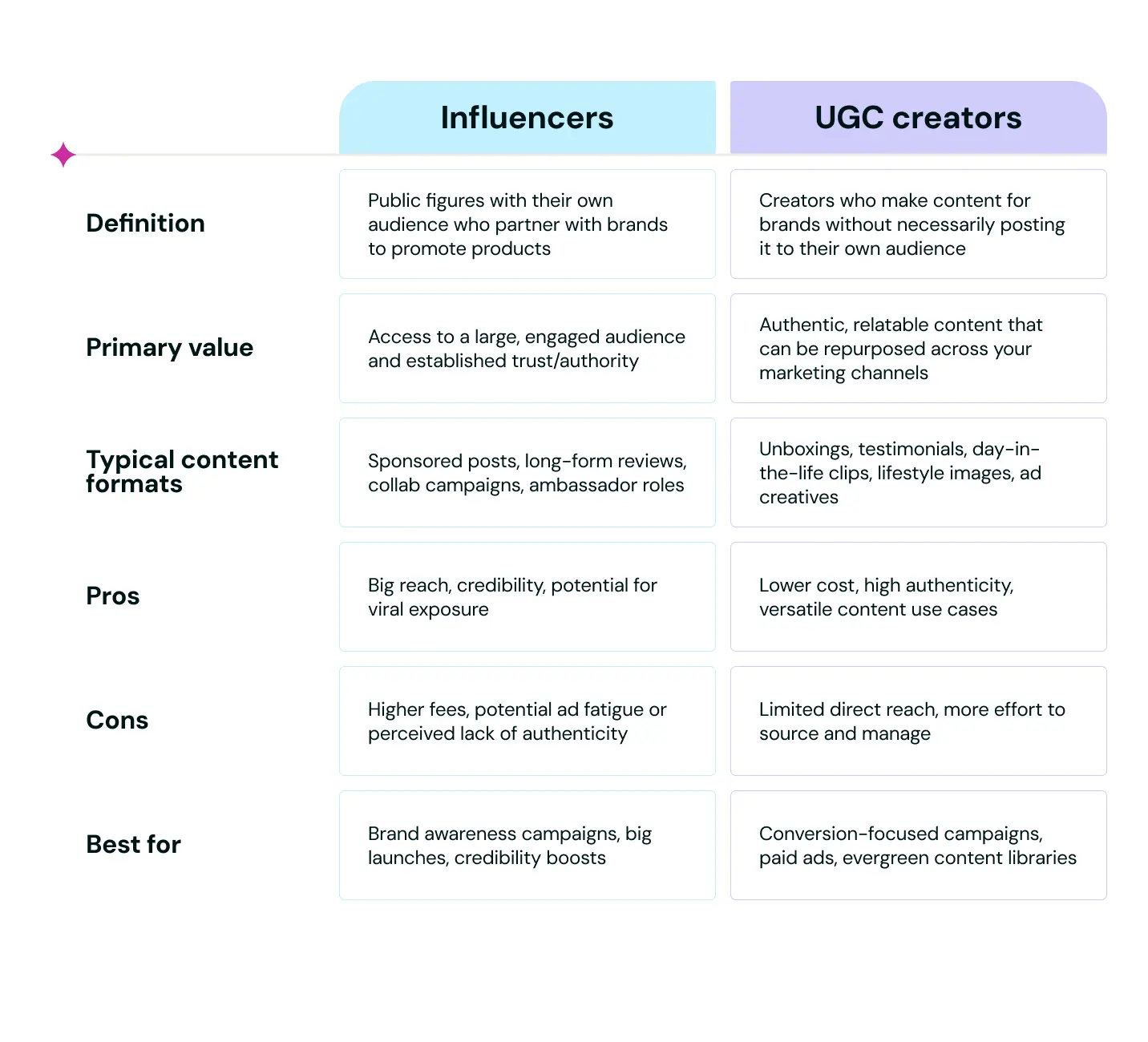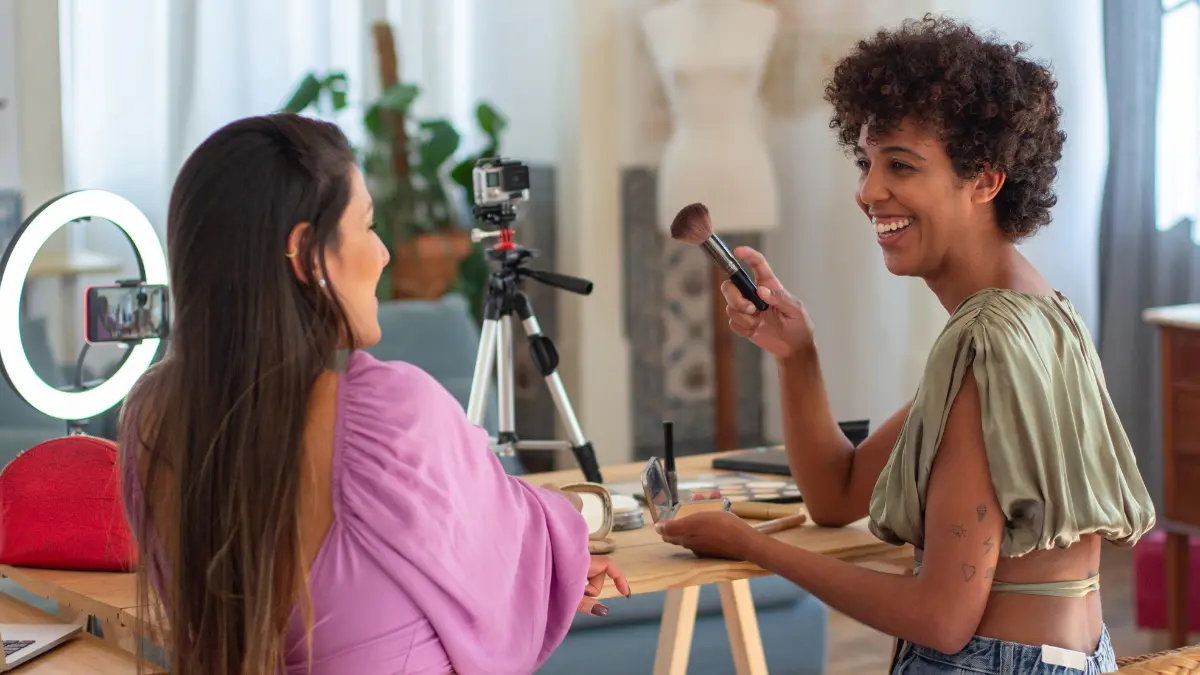Marketing in 2025 has a new set of stars, and we’re not talking about your traditional celebrities. Today’s spotlight belongs to influencers and UGC creators, both of which are shaping how brands reach and connect with their customers.
At first glance, it looks like they do the same thing: filming snappy TikToks, posting Reels, and showing off products in everyday life. But peek behind the feed and you’ll notice their roles are very different.
So, who should get your budget? The influencer with an audience of thousands hanging on their every word, or the UGC creator who specializes in scrappy, authentic clips you can repurpose across ads and campaigns?
In this guide, we’ll break down what really sets them apart, the pros and cons of each, and why the smartest brands aren’t asking “either/or” anymore, they’re actually figuring out how to harness both.
What Is an Influencer?
An influencer is someone who’s built an audience around a specific niche, like beauty, fitness, gaming, travel, or even something hyper-specific like tiny home living. Their power comes from the trust and authority they’ve created with that audience.
The typical content formats you’ll see influencers creating are:
- Sponsored Instagram Reels or TikToks showing a product in action
- Long-form YouTube reviews or tutorials
- Co-created brand campaigns, like launching a product line together or being the face of a brand’s seasonal push
- Ongoing ambassador partnerships where they weave a product into their regular content
There are plenty of pros of working with influencers.
They tend to have large, engaged audiences and can put your brand in front of thousands (or even millions) of people in one go. Their recommendations also carry a lot of weight because of their established credibility in their niche.
But there are some trade-offs. Big reach and authority can often come with a hefty price tag, and working with big names in any niche can get costly quite quickly. There can also be less perceived authenticity. Followers know influencers are being paid for their content, so sometimes their recommendations can feel less organic.
Here’s an example of an Instagram post by clothing brand Outerknown which showcases a selection of its influencer partners:
What Is a UGC Creator?
A UGC (user-generated content) creator is a little different. Instead of building a public audience of their own, they specialize in creating content for brands. It’s usually content that looks and feels like it could have come from a real customer.
Common UGC formats include:
- Unboxing videos showing off packaging and first impressions
- Short testimonials or storytelling videos about using a product
- Day-in-the-life clips featuring a product naturally in context
- Casual lifestyle photos and videos that can be repurposed for ads, emails, and social feeds
The good thing about UGC creators is you’re paying for the content itself, not for access to an audience, so it’s often cheaper than working with an established influencer. The content also feels raw, relatable, and less polished, which resonates better with today’s social media users, and it’s more versatile. You can use it across paid ads, organic social, product pages, email campaigns, and other channels.
The downside is, UGC creators don’t usually bring a big following of their own. Their value is in the content they produce, not necessarily in amplifying it. You’ll also need to put in more time to find creators who match your brand look because they aren’t as visible as influencers.
Here’s an example of UGC Olipop used to promote its latest product collaboration:
UGC Creators vs Influencers: A Comparison
UGC creator vs influencer… who do you pick? Here’s a quick comparison of them both so you can decide what’s best for your brand and campaigns.

Differences Between UGC Creators and Influencers
At the end of the day, both UGC creators and influencers help you put engaging, social-first content out into the world, but how they do it (and the results you can expect) are very different.
Let’s break it down.
Authenticity and Control
UGC is designed to look raw and real.
It mimics the kind of content everyday people post on their own feeds, which makes it feel less like an ad and more like genuine word-of-mouth marketing.
You can also guide UGC creators with scripts, briefs, or brand guidelines, which gives you a lot more control over the final output.
Influencer content, on the other hand, usually has a more polished, branded look. Their content fits within their personal style and aesthetic, which their audience expects. That can be a huge advantage if you want your product to blend into an aspirational lifestyle, but it also means you have less say over the creative direction.
Cost and ROI
UGC is the more affordable option by a long shot.
You’re paying for the content itself, not the creator’s reach, which means you can produce a steady stream of assets without blowing your budget. For brands running paid ads, this makes UGC incredibly cost-effective, because you can test dozens of creatives, see what sticks, and double down on the winners.
Influencers tend to charge higher fees because you’re buying into both their content and their audience. The upside is you get more predictable reach and the halo effect of their authority. The trade-off is cost: if you’re after consistent content volume, influencer campaigns can drain your budget faster.
Audience Reach and Trust
Influencers bring the numbers. They’ve spent years building up large, loyal followings, which means a single post can put your product in front of thousands of people instantly. Their audience also trusts them as subject-matter experts, so their recommendation carries weight.
UGC doesn’t come with built-in reach. Instead, it’s good at building grassroots credibility. When customers see multiple pieces of authentic-looking content (in ads, on your website, in email campaigns, for example), it reinforces trust and helps people imagine themselves using your product.
Speed and Scalability
One of the biggest benefits of UGC is how quickly you can scale it.
If you need a dozen product demo videos for next week’s ad campaign, you can get a handful of UGC creators to turn those around in days.
Influencer campaigns take more planning. You’re working around their schedules, negotiating deliverables, and syncing your launch with their content calendar. Yes, the payoff can be huge, but it’s definitely not as immediate as running a UGC campaign.
Combining UGC Creators and Influencers for Maximum Impact
You don’t always have to choose between UGC creators and influencers, in fact in many cases it’s smarter to use both. Each plays a different role in the buyer journey, and when you combine them strategically, you can spark awareness at the top of the funnel and keep the momentum going all the way through to conversion.
Fenty Beauty works with both influencers and creators. It did this collab with Aisha Potter:
And it also runs paid media UGC on Instagram and Facebook.

Here’s how you can also make the most of partnering with both types of creator.
Lean Into Hybrid Campaign Structures
Think of influencers as the spark and UGC as the fuel.
An influencer campaign can kick things off with a big, splashy moment, like a teaser Reel, a product demo on TikTok, or even a co-branded launch post that gets people talking. Once the buzz has started, UGC creators can step in to reinforce the message with authentic, bite-sized content that feels like it’s coming from real customers.
For example, you might:
- Launch with an influencer announcing your new product to their large, engaged following.
- Follow up by running UGC Reels and TikToks as paid ads to drive home social proof and keep showing your product in action in relatable, everyday contexts.
- Layer the two together to create a campaign arc that starts aspirational and ends highly relatable.
Create a Workflow on Insense
If you’re running a mix of UGC or influencer marketing campaigns, you’ll want a system that makes it easy to manage both types of creators in one place.
That’s where a platform like Insense comes in.

In the Creator Marketplace, you can source both influencers and UGC creators side by side, filtering by niche, style, and deliverables. Once you’ve chosen your mix, you can send out briefs through Campaign Management, so both sets of creators are aligned on messaging and creative direction.
This streamlines the process and makes hybrid campaigns much less overwhelming to coordinate.
Don’t Forget to Measure Success
To really understand the impact of using both UGC creators and influencers, you ideally want to look beyond vanity metrics and dig into how they complement each other.
You should aim to track things like:
- Engagement lift. Influencer posts can show whether you’re hitting the right audience and encouraging conversations.
- View-through rates. UGC ads are great for testing creative angles and seeing which formats keep people watching.
- Conversions. Track how both formats contribute to the bottom line in terms of sales or sign-ups.
UGC vs Influencer Content: What’s Your Choice?
At the end of the day, the “right” choice isn’t about which type of creator is better, it’s more about which one fits your goals and budget best.
If you’re chasing brand awareness and reach, influencers are the natural choice. They can get your product in front of thousands (or millions) of people and lend their authority to your message.
If you’re focused on conversion and content volume, UGC creators are the stronger bet. They give you affordable, relatable assets you can use across ads, product pages, and social feeds to build trust and drive action.
And remember, you don’t have to choose between UGC or influencer content! The smartest brands often use a mix: influencers to generate buzz and visibility, and UGC creators to back it up with a steady stream of authentic content that converts.
So instead of asking “UGC or influencers?”, the better question might be: How can you combine both to build a campaign that’s aspirational, authentic, and effective from start to finish?



.avif)






